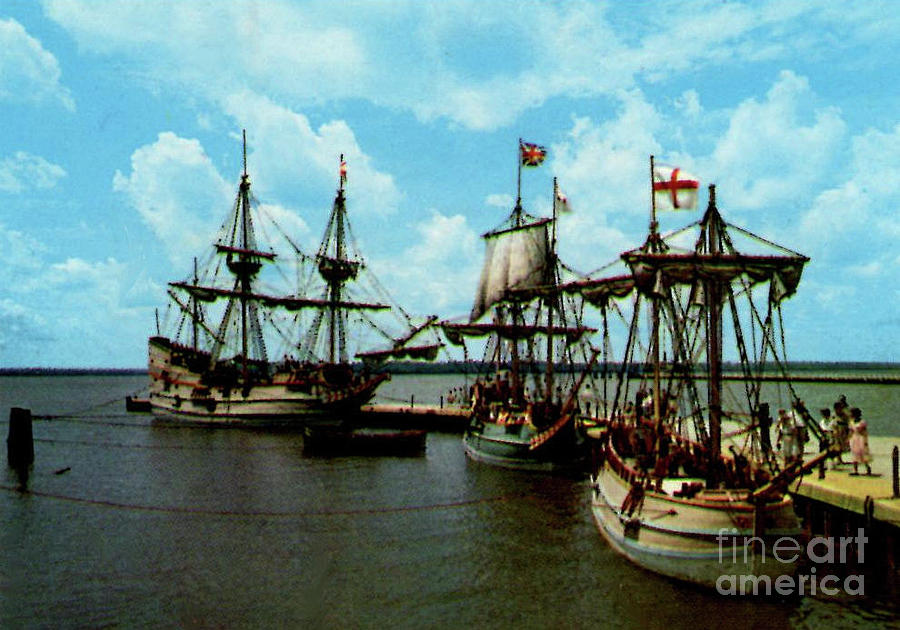

The upper part of the building holds an exhibit of Pre-Columbian art. The interpretive center contains an exhibit about 15th century society and exhibits related to Columbus's voyage of discovery including replicas of maps, arms, and treaties such as the Tratado de Tordesillas and the Treaty of Alcáçovas. Exhibits Interpretive Center Entrance to the Interpretive Center. August is the busiest month in terms of visitors. It is the third most visited tourist site in Andalusia. In 2007, nearly 200,000 people visited, roughly 550 people a day. Since then, the Wharf of the Caravels has been open to the public, with the number of visitors increasing each year. The resulting museum, inaugurated in 1994, is managed by the Diputación de Huelva, the government of Huelva province. The key to this project was the construction of the Wharf of the Caravels near La Rábida Monastery in Palos de la Frontera, one of the key Lugares colombinos, sites associated with the preparation and launching of Columbus's first voyage. These three boats formed part of the Seville Expo '92, and were part of numerous expositions throughout Europe and the Americas.Īfter they had been used in all manner of activities-including being used in filming 1492: Conquest of Paradise -the Andalusian Autonomous Government acquired the replicas as part of the project Andalucía 92. Among these, in Spain, was the launching of replicas of the ships in which Columbus and a crew that included the Pinzón Brothers of Palos de la Frontera, the Niño Brothers of Moguer, and other mariners from the region made the voyage that is generally accounted as the discovery of the Americas by Europeans. Throughout 1992 there were many celebrations of the fifth centenary of the Discovery of the Americas. The museum is operated by the province of Huelva, and has an area of 11,500 square metres (124,000 sq ft). The replica caravels were built between 19, put through shakedown voyages and then, in 1992, sailed the route of Columbus's voyage. These were built in 1992 for the Celebration of the Fifth Centenary of the Discovery of the Americas.

Its most prominent exhibits are replicas of Christopher Columbus's boats for his first voyage to the Americas, the Niña, the Pinta, and the Santa María. The Wharf of the Caravels ( Spanish: Muelle de las Carabelas) is a museum in Palos de la Frontera, in the province of Huelva, autonomous community of Andalusia, Spain. Official page on the site of the government of Huelva.
Replicas of nina pinta santa maria free#
Children under 4 years old receive free admission.Replicas of the Pinta, Niña, and Santa María at the Wharf. Touring the ships costs $8.50 per person, although older residents and students get a discounted rate. You can visit the Columbus Foundation website for a list of future docking locations. 28 and head for the Cincinnati riverfront, where they will dock from Aug.

They will be open to the public during normal business hours. The Columbus Foundation’s two ships have been sailing the seas over the last couple of decades, visiting different ports throughout the world. If you happen to live near Louisville, you can take a tour of the replica ships when they dock at the Louisville Wharf on Aug. The Pinta followed more than a decade later, departing Brazil in 2005. The Nina was the first replica to be completed, launching out of Brazil in late 1991. The replicas of Columbus’s two iconic ships were built by the Columbus Foundation, which was formed in 1986 in the British Virgin Islands in order to raise funds for the project. Replicas of the Nina and the Pinta will sail into Louisville, Kentucky this month before continuing their tour of U.S. But if you’ve ever wondered what it was actually like for Columbus and his crew to make that journey, you’ll now have your chance. Knowing that rhyme made it a breeze to ace that world history test on Christopher Columbus’ voyage to the “New World” - a complicated legacy that has come into sharper focus in recent years. “In 1492, Columbus sailed the ocean blue.” That’s a refrain you probably said in grade school - and I bet you still remember the names of his ships: the Nina, Pinta and Santa Maria.


 0 kommentar(er)
0 kommentar(er)
